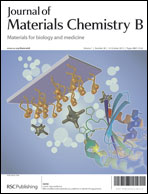The development of efficient multifunctional nanoprobes for tumour imaging has become a great challenge. Herein, we report for the first time the synthesis of folic acid (FA)-conjugated glutathione (GSH)-capped gold nanoclusters (Au NCs) for dual mode fluorescence/X-ray computed tomography imaging of gastric cancer. Water-soluble GSH-capped Au NCs were synthesized by using tetrabutylammonium borohydride (TBAB) as the reducing agent, and was characterized by transmission electron microscopy, UV-vis absorption spectroscopy, fluorescence spectroscopy, and X-ray photoelectron spectroscopy. The AuNCs@GSH showed excellent photoluminescence properties and negligible cytotoxicity at a concentration as high as 200 μg mL−1. Folic acid was covalently anchored to the AuNCs@GSH; the nanoprobe showed highly selective targeting of the gastric cancer MGC-803 cells revealed by laser scanning confocal microscopy (LSCM). Hematoxylin and eosin (HE) staining results showed that AuNCs@GSH displayed no toxicity to important organs. In conclusion, the FA-conjugated AuNCs@GSH nanoprobe can be used for gastric cancer fluorescence imaging and X-ray computed tomography (CT) imaging. Therefore, the applications of AuNCs@GSH could be extended and bring more benefits to nanotechnology as an ideal biomedical platform.

You have access to this article
 Please wait while we load your content...
Something went wrong. Try again?
Please wait while we load your content...
Something went wrong. Try again?


 Please wait while we load your content...
Please wait while we load your content...